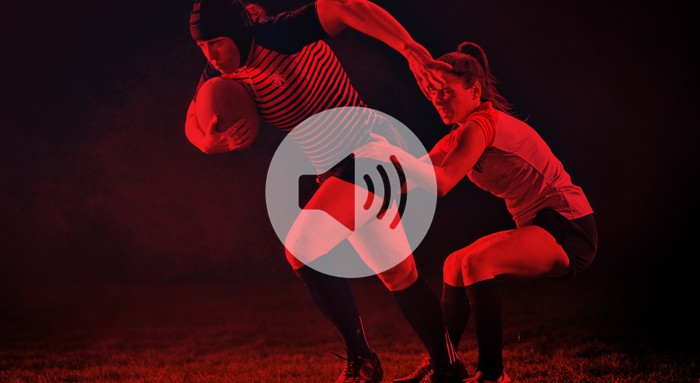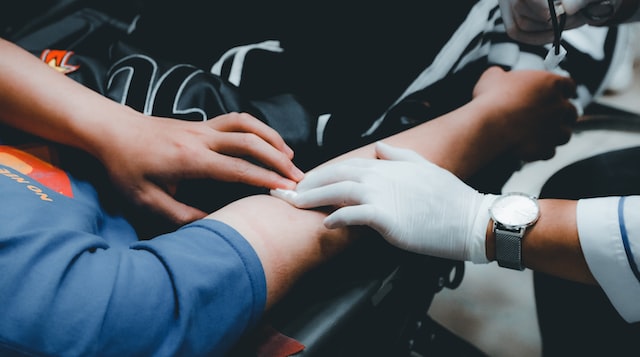
Credit: Getty
Two LGBTQ+ scientists describe how sexual and gender identities can help to drive research by offering perspectives that others in a lab group or collaboration might not have considered.
What role, for example, did gay scientists have in developing the direction of research into HIV and AIDS in the early 1980s, when the condition was erroneously seen as something that only affected homosexual men?
And how are transgender researchers helping to shape investigations into the physiology of transitioning women undergoing oestrogen therapy to underpin fairness in sport?
This episode is part of Science diversified, a seven-part podcast series exploring how having a more diverse range of researchers ultimately benefits not only the scientific enterprise, but also the wider world.
Never miss an episode: Subscribe to the Working Scientist podcast on Apple Podcasts, Google Podcasts, Spotify or your favourite podcast app.
Paid content: International Science Council (ISC)
The ISC is exploring diversity in science, and this episode is on representation and visibility. We hear how important it is to be able to express the whole of your identity in a safe and welcoming environment, where you can see allies and other people who are like you.
Marine biogeographer Huw Griffiths talks about initiatives for LGBTQ+ and allies working in polar science. And chemical engineer Abhijit Majumder discusses the role of science organizations in fostering welcoming spaces, including through explicit statements of support. Please note that this ISC episode, first published on 3 March 2021, has since been edited for clarity.
Find out more about this type of paid content
Transcript
Tom Welton and Blair Hamilton describe how queer perspectives drive scientific research.
David Payne: 00:04
Hello, I’m David Payne, careers editor at Nature. And this is Working Scientist, a Nature Careers podcast.
In this seven-part series, Science diversified, we’re exploring how the scientific enterprise truly benefits when you have a team of researchers from a broad range of backgrounds, disciplines and skillsets.
Each episode ends with a 10 minute sponsored slot from the International Science Council, about its work on diversity.
In this fourth episode, we turn our attention to sexual identity. We meet a gay chemist and a transgender sports scientist who are changing the world of science in their own unique ways.
Tom Welton: 00:43
So hello, I’m Tom Welton, and I’m professor of sustainable chemistry at Imperial College London. And I’m currently president of the Royal Society of Chemistry.
Diversity of sexuality is undoubtedly a positive for science, just as all diversity is a positive for science.
And it operates in two different kinds of ways. And so the first you can kind of think about, the culture of the laboratory, the culture of science, where having people from different backgrounds with different interests gives different points of views.
And so even in those areas of science which are seemingly the furthest away from humans and humanity, you know, just looking at that experiment with different eyes can sometimes mean that you see something that somebody else doesn’t.
And that has a general positive effect that is probably quite subtle. You wouldn’t necessarily be able to point it out and say, “Oh, that observation was made because that person was LGBT+ or whatever they were. But it does have a general positive effect having a diversity of views.
Blair Hamilton: 02:11
My name is Blair Hamilton. I am the lead researcher on the Tavistock transgender athletes study at the University of Brighton, in England.
So a trans women is someone who was born male, and transitions, legally and socially, to female, but obviously will still keep an XY chromosome. There’s things that during the transition that a trans woman probably will never lose, for example, you know, stature, longer bones, that sort of thing. However, obviously testosterone suppression is obviously when a transgender female (so a trans woman) takes medication to chemically reduce their testosterone levels before they have surgery.
So basically, it chemically reduces their testosterone to probably about castrate levels.
I am a transgender athlete in football. I grew up on the west coast of Scotland just outside a place called Kilmarnock. I didn’t exactly know, but I knew something was up from an early age, from probably about the age of four. Didn’t understand it, until you know, I was maybe about 16 or 17 that’s when the feelings really clicked for me.
And then I kind of, you know, because of social things. And obviously, the west coast of Scotland is not exactly the most, you know, forgiving place. So I tended to kind of suppress those feelings.
And I suppressed those feelings up until 2017, and 2017 on 1 January 2017 I decided I couldn’t no longer, you know, put everyone else first. I put myself first.
So that’s when the medical transition started on 26 January that year. Yes, so 26 when that happened. And then I play, I play football at quite a high level at that point. I played with the University of Aberdeen.
I played on the first team and the third team, which is odd because being a goalkeeper you kind of moved about, where you were needed.
Basically, at one point, it was in my last year, my fourth year of university they got the opportunity to switch after a year of my medication.
And then I started playing with the Aberdeen university women’s team and then I started playing with Stonehaven ladies, moving on to Grampian ladies, and then I now play with Montpellier Villa and University of Brighton.
So I’ve been around, it’s a little bit of a journey, but I’m happy where I am.
So obviously I take a testosterone suppressing injection once every three months, which again reduces my testosterone levels but I am also supplementing that with oestrogen patches.
The research is a unique collaboration between a gender identity clinic in London called the Tavistock Portman trust. And obviously the University of Brighton. So what we are looking at is testosterone suppression, in obviously transgender women, and the effects of their relative transitions on sport and performance.
The common sense approach right now is that transgender women are thought to have an advantage due to going through male puberty.
And what we are trying to elucidate, and actually try and highlight, is, does that really matter in terms of sport and performance?
So for example, you’re looking at in terms of running times between elite male and female runners is 10%.
And in terms of “does testosterone suppression in trans women, you know,with oestrogen administered as well, does that bring that 10% down into cisgender female levels?”
So we’re basically trying to see what the advantage is retained or not?
World rugby policy, just to let people know, has basically banned trans women from playing elite international rugby, based on a hypothetical model.
And I don’t believe that that should be the case. It should be on evidence. So that’s what we’re trying to do. So again, in terms of sports we’re studying, we’re looking into case studies, we’ve got five trans women lined up for our rugby study. And the same for football. The same for hockey as well. So we’ve got case studies going on as well.
Tom Welton: 06:51
And then, of course, there are very specific ways. And one good example is the emergence of HIV and AIDS in the 1980s.
The interest in, there’s something happening, the realization that there’s something happened, this is an important thing. And what was causing this dreadful disease, was, the discussions were very much led by gay men, whom it affected directly.
And of course, at that time, less was known about actually, it can and does affect everybody.
And those discussions of the science itself, and people choosing to do research to discover what was causing this dreadful disease, but also, the translation of that science, as the knowledge started to come into the broader community was very much led by gay men, who were using people like myself, (I did this myself), who were using their knowledge of science and their understanding of how science works.
And even though I was an inorganic chemist, and not a biologist, and certainly not a virologist, I was able to talk to people about what we knew, and what we didn’t know.
What was a piece of scientific information? What was the difference between saying, “We do not know that, it is not known,” and saying that, you know, this was A or B. And so therefore, your response to it should be C or D. And being able to explain that, and that activity was was, as I say, very much led by gay men.
And so it is a huge positive, that those diversities of experience are brought to bear on these big problems.
So one of the things which makes me very proud of the Royal Society of Chemistry community is, you know, the first time there was a planned election of its president, they elected a well-known out gay man.
And, in many ways, if you look back into, you know, back into when I was starting my career as a scientist in the 1980s, that would have been unimaginable.
And so I’m hugely proud of the community for doing that. Now, of course, that does have some consequences.
And, you know, presidents have their themes. And one of the big discussions we had was about, you know, the theme of diversity, which we already had in place, very much led by Leslie Yellowlees when she was president.
And it was sort of sort of realized that actually, just by being me, then diversity remains a really, really important theme.
It is a really important thing for the society anyway, and it would have carried on had I been a, you know, a heterosexual male, you know that it was not going to go away.
But having a president who comes from one of those backgrounds really does kind of keep the show on the road.
And so it was kind of, we don’t need to, in a way, make it a theme, because it already is one.
And it’s one in which we are doing very well. And so the job is not inventing it, the job is sustaining it and making it move forward. And so that’s kind of the way that I view diversity within my presidency and my presidency within diversity.
Blair Hamilton: 10:53
So the reason why all my work is important in sport, is that sport should be inherently fair. There is some unfairness inherent to sport. I mean, there’s going to be athletes, for example, let’s look at Usain Bolt for an example. There’s going to be athletes that are racing against him that are not going to beat him but they’ll try their hardest. That’s an inherent fairness or unfairness in sport.
However, we don’t believe in sport there should be an advantage due to obviously, you know, male physiology from like this kept beyond their transition.
And so we want to make sure that we’re also being inclusive, to make sure that we are, you know, incorporating transgender athletes and, and, you know, trying to be fair at the same time.
Again, we don’t want to make it “not inclusion, but being unfair”, its inclusion, but being fair to everyone as well.
David Payne 11:59
Now, that’s all for this section of our Working Scientist podcast. We now have a slot sponsored by the International Science Council, which looks at why diversity is so critical to advancing science and the steps we can take to improve it. I’m David Payne, careers editor at Nature. Thanks for listening.
Huw Griffiths: 12:20
When we think of diversity in science, or in academia in general, even if there is no, just for the argument’s sake, there is no measurable outcome. Still, I think it is our duty to make sure that this world is a safe, habitable place for everyone. No one should feel threatened.
Marnie Chesterton: 12: 47
Welcome to this podcast series from the International Science Council, where we’re exploring diversity in science. I’m Mani Chesterton, and in this episode, we’ll be looking at representation and visibility, we’ll be hearing how important it is to be able to express the whole of your identity in a safe and welcoming environment, where you can see allies and other people who are like you. And we’ll look at the role of organizations in fostering these spaces in science, including through explicit statements of support, which really can make a difference. We’re starting by going to Antarctica.
Huw Griffiths: 13:27
I can spend two or three months on a ship, living amongst the icebergs looking at what lives at the bottom of the sea. And one of the really exciting things is being able to discover new species. So probably about 10 to 20% of what we find is brand new to science.
Marnie Chesterton: 13: 42
This is Dr. Hugh Griffiths from the British Antarctic Survey.
Huw Griffiths: 13:45
I work in mostly the polar regions of marine biogeography. Someone who looks at where animals live, and why they live there. So why they’re distributed in some places and maybe not found in other places. For example….
Marnie Chesterton: 13:59
Huw is also involved with the Scientific Committee on Antarctic research, or SCA, which is a thematic organization of the International Science Council.
Huw Griffiths: 14:02
So the Scientific Committee on Antarctic Research, or SCA, as it’s called, which sounds like a bond villain’s kind of name, actually has been sort of a huge part of my career.
So early on, I was involved with scientific projects that were led by other people within SCA, and today, I am the co-chair of one of the biology programs within the organization. But also I’m on all sorts of other committees and things as well. So, for me, it’s a brilliant way of networking with international colleagues.
And because Antarctica is such a huge place where no one country could do all the research, you do need to connect up with other nationalities and that’s kind of an ideal way of both meeting new friends and colleagues and for helping to get brand new collaborations that help answer some really big questions.
Marnie Chesterton: 14.54
According to Huw, this need for collaboration within Polar Research means it’s home to have that very diverse community of scientists.
Huw Griffiths: 15:02
In all senses of the word, all sciences are covered in Antarctica. We’ve got engineering, we’ve got biology, we’ve got atmospheric sciences, we’ve got all these different things.
And so it’s a melting pot for different types of science as well as different types of people.
And because it’s so International, you’ve already got to deal with lots of different cultural backgrounds anyway.
So it’s not a huge step for us to move on to include things like sexuality, gender, or disability, for example,
Marnie Chesterton: 15.30
Indeed, on 18 November, the International Day of LGBTQIA, plus people in STEM, the Polar Research community got together for the first polar pride day.
Huw Griffiths: 15.42
We put out a load of things on social media and thought it will be a few pretty pictures and people you know, with rainbows and penguins, and things. But actually, there were some really heartfelt comments in some of the things that came back to us, like people saying that the fact that we’ve given out pins and badges to senior members of staff to wear that showed that they were allies meant that there were people staying within polar research because they finally found a place where they felt welcome and safe.
Marnie Chesterton: 16.08
Something as simple as a badge can go a long way to making people feel secure, that science workplaces or conferences are a safe space where they’re welcomed and accepted. The importance of creating environments like this within science can’t be overstated.
Abhijit Majumder: 16.26
Unless any person feels safe, feels welcome, how do we expect that we will get the best out of those people? So, I think it is very important, whether it is a lab it is an institute, it is any organization, we need to make the place safe.
And in this particular context, just making it a safe place is not enough, because there are you know, lots of taboos that is associated with it.
So that’s why it is very important to explicitly mention that we don’t care what sexuality what gender expression you are, we are open to you. So this explicit statement is important in this context.
Marnie Chesterton: 17.14
That’s Abhijit Majumder, associate professor in the department of chemical engineering at the Indian Institute of Technology in Bombay, and part of the global Young Academy, an affiliate member of the ISC.
Abhijit Majumder: 17.27
The purpose of the Global Young Academy is to make the voice of young academicians hope, both in terms of improving the quality of the life of the researchers, quality of science, as well as interaction between science and society. We look into how as investigators we can contribute towards the society.
Marnie Chesterton: 17.51
Within the GYA, Abhijit is co-leading an initiative that works towards creating a safe space for people to discuss discrimination faced by LGBTQIA plus, and other minority groups within academia.
Abhijit Majumder: 17.27
I was inducted to the GYA in 2018, and then at the annual meeting, we found that there is no group or no incubator, no working group addressing this issue of gender expression and sexuality.
Our first goal is just to let the new people, new members know that this is a safe place, and they can express themselves, their gender expression and their sexuality and will not be judged rather, it will be embraced.
And we are trying to at least to make this mark in the Global Young Academy that it’s okay, it’s a safe place.
Marnie Chesterton: 18.57
That included adding new language to the academy’s public statements on diversity.
Abhijit Majumder: 17.27
That statement says how globally an academy is open to all various different kinds of race, color, etc, etc, gender, etc.
But however, the explicit mention of sexuality and gender expression, these were not present in that diversity statement.
So then we kind of brought up this topic and it was again, very heartily accepted. And then now it is part of our diversity statement.
Marnie Chesterton: 19.31
Statements on diversity by international organizations such as the IRC and the GYA have an important role to play ensuring support, breaking down barriers and ultimately sowing the seeds for change.
Abhijit Majumder: 17.27
Do you need to increase the earnings First of all, but also to get actively involved with the National Academies? And to ask them, get them into the discussion table and Funding whether the government will follow that or not, that is obviously a very different question. But at least if the National Science academies they put pressure on their respective government to act least to start with to ask least legalize the gender expression and various forms of sexualities, I think that will be a great start.
Marnie Chesterton: 17.46
Having an explicit statement on openness and diversity can be a useful starting point. One of the five key missions of the ISC is to defend the free and responsible practice of science. This principle is reflected in all of the IRC is policies and operational guidelines, and they have a dedicated committee to oversee this. commitments like this are particularly important for scientists who need to travel and collaborate in different settings, which may be less accessible than their usual places of work, or even unsafe.
Abhijit Majumder: 21.00
Sometimes you just need some guidelines and help from people who’ve been through these experiences or who are disadvantaged, to help set up different ways of working. For example, we the new ways of working in the pandemic have really helped us to show that disabled people can attend conferences or work remotely on field work and things because we’ve had to set up different ways of communicating. And we should bring them forward with us, even when hopefully Coronavirus is long behind us to show that we can actually change the way we work. So that we don’t stop doing things in countries where it may be illegal to be gay, but that we allow people to attend or participate in events there where they feel safe, whether it’s through safe spaces, or actually just remote attendance, for example. But it is hugely impactful on people’s careers. That is something where if conference organizers and these are made aware, then that can all be fed into guidelines, and make people within science a lot more comfortable. And even just knowing that somebody thought about it, even if the solution is not perfect, will make you feel as if you’re part of a community where things are at least being considered and they’re doing their best for you.
Marnie Chesterton: 22:04
For organizations like the IRC, the freedom to participate in science is something that needs to be reasserted continually in the face of barriers.
And that also means recognizing that people may experience different types of discrimination that intersect.
Huw Griffiths: 22.19
It is really important that we recognize things like intersectionality, or developing nations or countries where people don’t have the same rights and freedoms as we do.
And we learn from each other’s experiences, because I’m a cisgendered, white male.
So my experience as a gay man in science is very different to a black female LGBT person, for example, I don’t have a whole bunch of other barriers, I have quite a bit of privilege. So although I can recognize where I may be disadvantaged, actually, I can’t speak for everybody in the community.
Marnie Chesterton: 22.55
Diversity and Inclusion is about making science accessible for each and every person. And by doing that, all of science stands to gain,
Huw Griffiths: 23.05
It’s very important that we open the doors to everybody to have a voice.
And if those voices are heard, then it will be better for everybody if you make a nicer working environment or a more friendly place to be everybody benefits.
So it’s not a pie where if I have my slice, you’ll get a smaller slice. It’s something where if I’m happier than other people don’t have to put up with me being miserable. So it’s a win win.
Marnie Chesterton: 23.29
The ISC Committee for Freedom and Rresponsibility in Science is currently reexamining and re articulating what scientific freedom and responsibility means for the 21st century, including when it comes to equal access to the scientific endeavor, and its benefits for all more information about this work, and about the IRC members and networks mentioned in this podcast is available online at council dot science.
Next week, we’ll be talking to two early career researchers about the importance of democratizing knowledge and access to tools data and infrastructure, and how as well as securing basic human dignity. It can also support different routes into science for people from diverse backgrounds.







